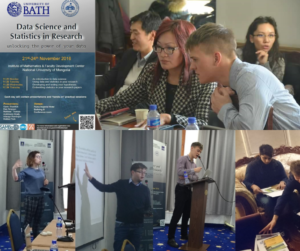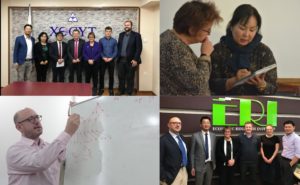In late November 2016, 10 keen students and academics made the long journey to Ulaanbaatar, the capital of Mongolia, for a research trip aiming to build links between Mongolia and the University of Bath.
Upon arriving in temperatures reaching -30 degrees Celsius, a few wondered what they had let themselves in for. Even Andreas Kyprianou, who knew Mongolia well, had never visited before in winter and was a tad apprehensive.
Left: the long journey from Bath to Ulaanbaatar, involving a stop off in Beijing. Right: arriving at Chinggis Khaan airport in Mongolia.
The aim of the trip was to help develop the Mongolian industrial mathematics and statistics capability. It was hoped this would help the country form evidence-based policies that will drive economic, industrial and environmental development. A team from the University of Bath was hence formed of individuals that could help build collaborative links between policy makers in Mongolia to generate high impact research activity, and deliver a course in statistics to provide training for young academics and workers. This included representatives from SAMBa, the Statistics group, IMI, IPR, and four postgraduate students.
The course was primarily run by the postgraduate students and had a large amount of interest with hundreds of applications. A suitable venue was identified which allowed for 130 participants from Mongolia to attend. The material began with motivational examples of the use of statistical analysis such as the use of clustering methods on electricity usage data to better predict electricity demand. The participants were introduced to statistical software R, and shown how to use it for initial data analysis and data visualisation. The course moved onto methods for hypothesis testing including how to pick the right test for different types of data. It concluded with methods for linear regression and clustering. Many of the participants had their own data from academic or public sector projects, and a lot of queries related to importing and analysing this data.
On the first day of the course, a TV crew recorded a report for the state TV channel MNB. A 3-minute long segment involving interviews was broadcast on the news on 22nd November 2016. At the time of writing, the report is available to view on the MNB website (22:00 mins).
Given the language barrier, it was found necessary to speak relatively slowly, and pause for a translation after every phrase. This was useful in developing the skill to speak in a concise articulate way, and to avoid using serpentine sentence construction (which I for one was previously guilty of when giving talks!).
Logistical challenges arose including intermittent WIFI access due to the large amount of people in the course. This was countered by the downloading of relevant materials including R software and packages onto many memory sticks for circulation.
Delivering the course was an enjoyable and extremely beneficial experience for us. The participants of the course were extremely friendly and it was genuinely a joy to work with them.
Top left: Poster advertising the statistics course. Top right: Robbie Peck assisting a course participant with the installation of the relevant statistical software. Bottom: Aoibheann Brady, Matt Thomas, Robbie Peck, and Adwaye Rambojun preparing and delivering the statistics course.
The other half of the University of Bath team took the lead in meeting policy makers to build future potential collaboration links. This included representatives from the National University of Mongolia, and the Ministries of Health, Energy, National Strategy. This proved fruitful with many different leads for collaboration with academic and public sector projects.
One potential collaboration involved looking at air pollution and tuberculosis records within Mongolia. The burning of untreated coal to fuel the large heating cost in Ulaanbaatar meant that the PM10 concentration in the city was relatively high. A possible direction would be to fit a model to pollution levels across space and time to ‘fill in the gaps’ where there are not records. One could then cross reference this with the tuberculosis records to measure any association between air pollution levels and tuberculosis diagnoses. It is hoped research such as this will have weight in influencing public policy through the links established with the public-sector workers we met.
Furthermore, Professor Gavin Shaddick ran a workshop in air pollution which began with talks from academics from Bath and Mongolia. This then followed the style of a SAMBa Integrative Think Tank by having cross discipline group discussions to identify problems and research questions, and then short presentations about directions one would take to tackle them. For each problem, a contact in Mongolia was identified to be the catalyst for future work in that area.
Top left: Meeting at the Public Health Institute. Top right: Julie Barnett in a discussion during a workshop on Epidemiology and Public Health. Bottom left: Andreas Kyprianou working through some ideas during a workshop on Ecology. Bottom right: Meeting at the Economics Research Institute.
Once the week had finished, we celebrated all the new potential future collaborations with a Mongolian feast. The food was particularly delicious, involving large amounts of tender meat and traditional Mongolian salads and sides. To our new Mongolian friends, we said “Баярлалаа!”, and hope to return to Mongolia in 2017 to ensure the successful development of the ongoing collaborations and to perform further training courses.
Respond




